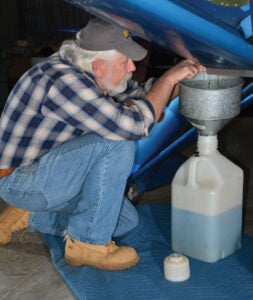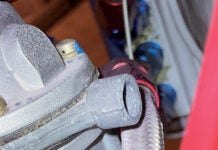One of the compelling reasons to aviate is it can demand the ultimate payment, and with an impartiality Hemingway appreciated. That alone elevates flying above a game and tends to focus our interest in favor of increased professionalism. In a world made safe to the point of never really thinking about it, at least on the daily living level, this is a precious thing, heartless as it is.
And so I opened my bag of luck the other day and transferred some credits from it into my bag of experience with an appreciative frame of mind. I say appreciative deliberately, perhaps because I’m writing this on Thanksgiving morning—and given the delays inherent to the printed word, you’re reading it closer to Easter—plus we must be grateful when we discover good old dumb luck has pulled our forgetful carcass back from the edge yet again.
Like many a cautionary aviation tale, this one begins with describing a fuel system, in this case the one in my Starduster Too. There is a main fuel tank in the fuselage and an auxiliary tank in the center section of the upper wing. The fuel selector valve has Wing, Main, and Off positions so that it’s possible to feed the engine from either tank but not drain the auxiliary tank into the main.

Occasionally it’s desirable on preflight to empty the aux tank into the main by draining the aux into a can and pouring it back into the main. Aerobatics might be the thing for an upcoming flight, which means an empty aux tank is mandated. Or due to the sometimes long periods between flights, coupled with the typical marginally accurate fuel gauge, especially in a tail-down position on the ground, I can’t quite remember or figure how much fuel is in the main tank (and you can’t stick it). In that case, the best thing is to simply fill the main and start the fuel calculations from a fresh baseline. I have no need to run out of joy juice.
Furthermore, when the aux tank gets down to the final five or seven gallons, accessing that fuel in flight can require accommodation that gets in the way. That’s because the fuel gravity feeds from the left rear corner of the suitcase-shaped tank, so if the airplane is pointed downhill with a low aux tank, it absolutely will unport the fuel line. It will even do the same in still air with an annoying randomness in level flight around the seven gallons remaining point. In any case, to get the last 20 minutes out of the aux tank means purposefully crabbing left wing low, which gets old about two minutes into the drill.
A week or so previously, I drained the aux tank to the main in preparation for a cross-country I wanted to make three days later. I would be out of town for those intervening three days and didn’t need to take time configuring the plane on the day of the future flight. Therefore, in a rare case of thinking ahead, I got out the fuel jug and funnel, and set up same under the gascolator fuel drain. Popping the drain’s difficult little tee handle into the open detent, I could then conveniently control the fuel flow with the fuel selector valve as I transferred what turned out to be about eight gallons into the main tank.
Of course, three days later the proposed flight was canceled and I went sullenly about my ground-based life for another week or so. There were chores and stories to write, lousy weather, appointments to keep, and I’m sure my grounded aviator mood didn’t help my cause around the house. But a week later, the weather and a reason to fly all came together, and I wheeled the ’ol box kite out of the hangar.
It was good to have that anticipation of flying as I preflighted the crate. In the cockpit I flipped the usual switches, pushed in the mixture control and toggled the boost pump to prime the injected engine. The pump ran a bit raspy, like it does when it’s dry, which is normal if you’ve been draining tanks and lines. The starter got the Lyc making noise after two blades and then the engine note went flat and then died. “Hmm, no gas.”
“Oh yeah, I was draining fuel a week ago.” I reached down to the fuel selector valve and sure enough, it was in the Wing position. I knew that was empty—and not the tank ever used for ground ops or takeoff and landing anyway—so I switched it to Main and re-primed and restarted.
And once again the engine was flat sounding and died after a lackluster quarter minute.
“That’s not right…it’s still out of fuel for some reason.” Sitting there thinking about it, I soon thought I heard faint sounds of running liquid—like water trickling out of a tap on the other side of a wall. It was mercifully quiet there in front of my hangar. There were no planes overhead or taxiing nearby, no car traffic or even wind. As is my habit, I wasn’t wearing my helmet or headset yet as I prefer to listen to every nuance of the starter and engine during engine starts. Had I been wearing a headset I would never have heard a thing.
Of course, it wasn’t water as I knew already. The gascolator drain was still in the open position. Evidently I had never secured it a week ago, and with the wing tank dry there was nothing to leak. But once I selected the main then fuel was flowing out the gascolator, which accounted for the lean-running engine. Of course this was puddling under the airplane where I couldn’t see it.
The cure was simple enough—get out, close the gascolator drain and get back to business. But what if I had put on my headset or an engine had been running nearby? I never would have heard anything. And given some suction from the engine-driven pump and a bit of time to get even a little fuel flowing, could the engine have started and run? Could I have gotten to the runway and tried a takeoff, only to end up sputtering into the flower field at the end of our runway? No way, given the 540’s appetite for fuel, especially at takeoff, but it got me wondering. Would a carbureted engine run with an open fuel drain? If the float bowl was full, then it could easily take you to the scene of the accident. Heck, my old friend Ernie showed us how and his new widow told us about it at his funeral—she had been sitting next to him. The selector was on an empty tank on that one. Did someone smarter than me many years ago purposefully size gascolator drains large enough to ensure no engine will make takeoff power for just this reason? Is shuttling fuel around the airplane by draining tanks that great a policy? What if there had been a spark nearby?
This was a new way of fouling up, so there must be some lessons to be had, and for only the price of a couple cups of gasoline, too. For one thing, I think I better start checking that fuel drain during preflights. Sure, I was taught to sump the fuel system in primary training, but for some reason it’s never been on the Starduster walk-around. That little tee handle is a real pain, half buried in a tiny hole in the cowling. Only I operate the plane, it’s hangared and with big cowling doors I open to inspect the engine during preflight, I visually check the gascolator bowl for foreign junk. So yeah, I cycle the gascolator drain more often as a source of cleaning fluid than during preflight—but maybe I should at least check it for staining and to be sure it’s closed.
More fundamental is the design of the fuel system. It’s simple, a big plus, but the inability to drain the aux tank into the main has always been a bother. Doing so could mean using all the aux tank fuel without having to run the tank dry—always a memorable event for the wife—then switching over to the main and waiting for the engine to restart (the part I like). It would be nice to avoid the whole can-and-funnel drill, too. In all, it’s something to consider when plumbing a project. Better to let guys like Hemingway find something else to write about.













